Power Steering System -- On-Vehicle Inspection |
| 1. INSPECT DRIVE BELT |
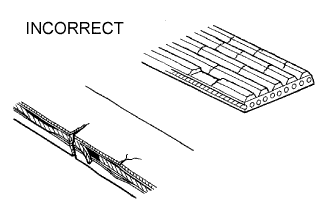 |
Visually check the belt for excessive wear, frayed cords, etc. If any defect is found, replace the drive belt.
- HINT:
- Cracks on the rib side of the belt are considered acceptable. Replace the belt if there are any missing ribs.
| 2. BLEED AIR FROM POWER STEERING SYSTEM |
Check the fluid level.
Jack up the front of the vehicle and support it with stands.
Turn the steering wheel.
With the engine stopped, turn the steering wheel slowly from lock to lock several times.
Lower the vehicle.
Start the engine. Run the engine at idle for a few minutes.
Turn the steering wheel.
With the engine idling, turn the steering wheel to the left or right full lock position and hold it there for 2 to 3 seconds. Then turn the steering wheel to the opposite full lock position and hold it there for 2 to 3 seconds.
Repeat the step above several times.
Stop the engine.
Check for foaming or emulsification. If the system has to be bled twice because of foaming or emulsification, check for fluid leaks in the system.
 |
Check the fluid level.
| 3. CHECK FLUID LEVEL |
 |
Keep the vehicle level.
With the engine stopped, check the power steering fluid level in the oil reservoir. If necessary, add power steering fluid.
- Power steering fluid:
- ATF "DEXRON'' II or III
- HINT:
- If the fluid is hot, check that the fluid level is within the HOT range on the oil reservoir. If the fluid is cold, check that the fluid level is within the COLD range.
Start the engine and run it at idle.
Turn the steering wheel to the left or right full lock position, and then turn the wheel to the opposite full lock position. Repeat this several times to raise fluid temperature.
- Standard fluid temperature:
- 75 to 80°C (167 to 176°F)
Check for foaming or emulsification. If foaming or emulsification is identified, bleed air from the power steering system.
 |
With the engine idling, measure the fluid level in the oil reservoir.
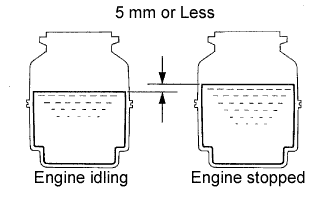 |
Stop the engine.
Wait a few minutes and remeasure the fluid level in the oil reservoir.
- Maximum fluid level increase:
- 5 mm (0.20 in.)
Check the fluid level.
| 4. CHECK STEERING FLUID PRESSURE |
Disconnect the pressure feed tube.
For 1GR-FE, refer to the following procedures (Toyota Fortuner RM0000013NO003X.html).
For 1KD-FTV refer to the following procedures (Toyota Fortuner RM00000163B004X.html).
Connect SST as shown in the illustration below.
- SST
- 09640-10010(09641-01010,09641-01020,09641-01030)
- NOTICE:
- Check that the valve of SST is in the open position.
Bleed air from the power steering system.
Start the engine and run it at idle.
Turn the steering wheel to the left or right full lock position. Then turn the wheel to the opposite full lock position. Repeat this several times to raise fluid temperature.
- Standard fluid temperature:
- 75 to 80°C (167 to 176°F)
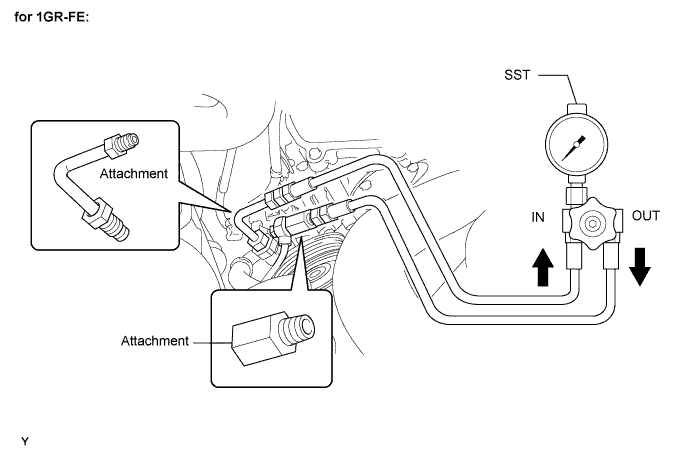
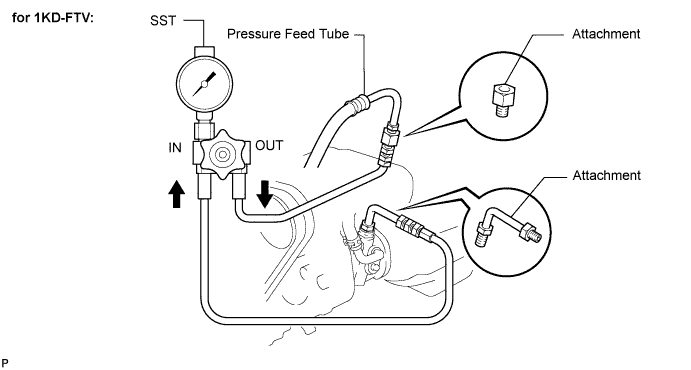
With the engine idling, close the valve of SST and observe the reading on SST.
- Minimum fluid pressure:
- 8,300 kPa (84.6 kgf/cm2, 1,204 psi) for 1GR-FE
- 8,800 kPa (89.7 kgf/cm2, 1,276 psi) for 1 KD-FTV
- NOTICE:
- Do not keep the valve closed for more than 10 seconds.
- Do not let the fluid temperature become too high.
 |
With the engine idling, fully open the valve.
 |
Measure the fluid pressure at engine speeds of 1,000 rpm and 3,000 rpm.
- Standard fluid pressure difference:
- 490 kPa (5 kgf/cm2, 71 psi) or less
- NOTICE:
- Do not turn the steering wheel.
With the engine idling and the valve fully opened, turn the steering wheel to the full lock position.
- Minimum fluid pressure:
- 8,300 kPa (84.6 kgf/cm2, 1,204 psi) for 1GR-FE
- 8,800 kPa (89.7 kgf/cm2, 1,276 psi) for 1KD-FTV
- NOTICE:
- Do not maintain the lock position for more than 10 seconds.
- Do not let the fluid temperature become too high.
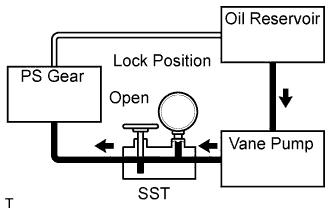 |
Disconnect SST.
- SST
- 09640-10010(09641-01010,09641-01020,09641-01030)
Connect the pressure feed tube.
For 1GR-FE refer to the following procedures (Toyota Fortuner RM0000013NM003X.html).
For 1 KD-FTV refer to the following procedures (Toyota Fortuner RM00000138G005X.html).
Bleed air from the power steering system.
| 5. CHECK STEERING RESISTANCE |
 |
Center the steering wheel.
Remove the steering pad (Toyota Fortuner RM0000010AS003X.html).
Start the engine and run it at idle.
Measure the steering resistance in both directions.
- Standard steering resistance (Reference):
- 5.5 N*m (56 kgf*cm, 49 in.*lbf)
- HINT:
- Tire type, tire pressure and type of surface beneath the vehicle should be taken into consideration before making your diagnosis.
Tighten the steering wheel set nut.
- Torque:
- 50 N*m{510 kgf*cm, 37 ft.*lbf}
Install the steering pad (Toyota Fortuner RM0000010AQ003X.html).